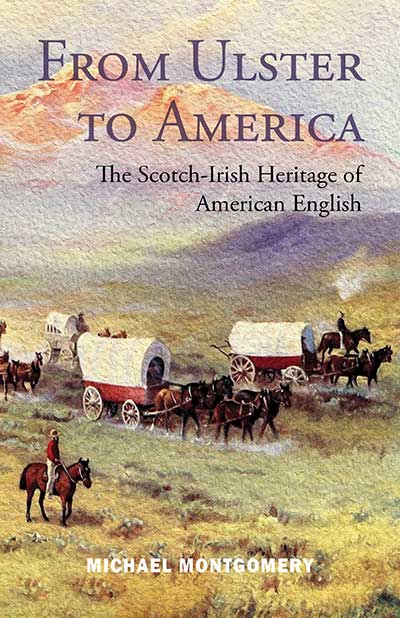diamond - From Ulster to America
Source: From Ulster to America: The Scotch-Irish Heritage of American English
Author: Michael Montgomery
Comments: From Ulster to America recounts the lasting impact eighteenth-century settlers from Ulster have made on the development of the English language of the United States. The book documents over 500 vocabulary items contributed to American English by these ‘Scotch-Irish’ settlers. Each ‘shared’ term with its meaning is authenticated by quotations from both sides of the Atlantic. This searchable online version of his book takes its text from the dictionary part of the second edition published by the Ullans Press in 2017.
diamond, diemon n A rectangular design of town square dating from the period of the Plantation of Ulster in the early 17th century. See citations.
Ulst.:
1840 Boyce Shandy Maguire 69 Then the riot became serious. The white ribbons rallied round the corner of the Diamond from every part of the fair, and aided, as they were, by friends and relations who had never joined, and others who had already abandoned the society, made a formidable force.
c1910 Byers Glossary: diamond = a sort of rectangular space in the centre of towns like Raphoe, Carndonagh, Malin, Coleraine, Monaghan. In other towns called ‘the Square’.
1975/76 Adams Diamonds 19-20 The Public Record Office of Northern Ireland states that on Francis Neville’s map of Londonderry, published in 1693/95 to illustrate the siege, the central square is named as ‘The Dymond or Market Place’. The date is over twenty years before Ulster emigration to America began and the spelling indicates a common Ulster pronunciation of the word … The term may be English rather than Scottish in origin. Perhaps a search through the street-names in those areas whence the Plantation settlers came would reveal its ultimate source.
1978 Ulster Folk Ways 14 [At the turn of the century] as in Castlewellan, County Down, weekly markets and periodic animal fairs were normally held in the squares (or ‘Diamonds’ as they were usually called [in the west of the province]) at the centre of the small country towns.
1994 Robinson Diamonds in Stone 28 Plantation town planning was not restricted to the development of a regional urban plan, but involved the planned development of individual settlements too. Both Killyleagh and Moneymore were laid out on what essentially a cross-shaped pattern, focused on a central market. Other plantation towns such as Lisburn, Newtownards, and many others, developed more haphazardly along a ‘Main Street’ which was widened at one end into a market place or ‘Diamond’.
2001 Harvey Diamonds in Rough 108 Patrons of new or refounded towns [in the Ulster Plantation] were directed to make provision for market places … This frequently resulted in a layout illustrated clearly in the two most obviously planned towns of Londonderry and Coleraine. The towns have slightly different ground plans, but share several features: a layout on rectilinear lines, with streets crossing at right angles on a grid plan and, in the center, a large open area, in the shape of either a square or rectangle, at which two or more main streets intersect. Public buildings — a town hall, prison, or market house — were sited on the square … This square would acquire a uniquely Ulster name, ‘the Diamond’, and it would become a common name for central marketplaces in central and west Ulster; examples can be seen in the towns of Monaghan, Crossmaglen and Enniskillen, among others. Ibid. Harvey Diamonds in Rough 109 Numerous examples of ‘diamonds’ in Pennsylvania may be cited: in Elizabethtown in Lancaster County and Carlisle in Cumberland, both in the areas of earliest Scotch-Irish settlement; as well as one in Pittsburgh, reflecting the marked Scotch-Irish influence in western Pennsylvania. Ibid. 112 As settlement expanded, Springfield [Pennsylvania]’s commercial center moved in a westerly direction, toward the junction of the two stage routes in the central area — termed a square in Stroup’s original town plan, but quickly called ‘the Diamond’ by its chiefly Scotch-Irish inhabitants.
2014 Fenton Hamely Tongue 65 diemon = (usually the Diamond) the market square in a village or town.
U.S.:
1829 Royall Pennsylvania 55 In all the towns of Pennsylvania, of any size, the public buildings and offices are built on squares, in the centre of their town … These squares are uniformly called ‘The Diamond’.
1969 Evans Cultural Adaptation 85 In … Rehrersburg [Indiana], the street incorporates an elongated market place which is significantly known as ‘the Diamond’, a word which seems to be used elsewhere in this connection only in Ulster, though it is found in some American towns outside Pennsylvania, e.g. Cleveland, Ohio.
Purchase From Ulster to America
 The second, revised edition of Michael Montgomery’s From Ulster to America is now available here:
The second, revised edition of Michael Montgomery’s From Ulster to America is now available here:
From Ulster to America: The Scotch-Irish Heritage of American English (Europe)
From Ulster to America: The Scotch-Irish Heritage of American English (North America)

